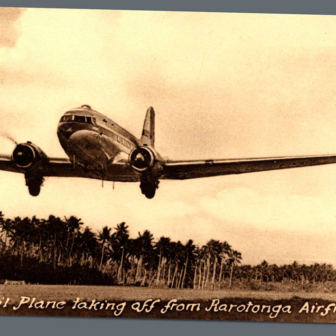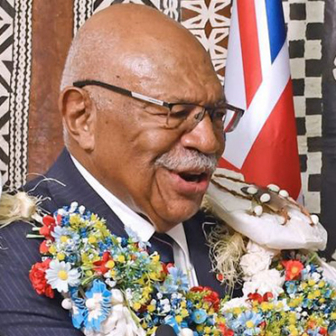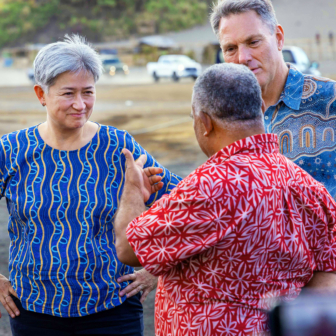AT THE height of the nuclear arms race between the United States and Soviet Union, a treaty to create a South Pacific Nuclear Free Zone, or SPNFZ, was opened for signature on Hiroshima Day, 6 August 1985, at the Pacific Islands Forum meeting in Rarotonga.
Twenty-eight years after it was signed on that day by Australia, New Zealand and island nations, the United States still hasn’t ratified its protocols, in spite of a request from president Barack Obama to the US Senate more than two years ago.
Next week, as Forum leaders gather in the Marshall Islands – site of sixty-seven US nuclear tests at Bikini and Enewetak Atolls – the US government will be eager to keep nuclear issues off the agenda, as it has been since the Treaty was first mooted. Declassified documents from the National Archives of Australia, and US diplomatic cables published by WikiLeaks, highlight longstanding opposition in Canberra and Washington to a comprehensive nuclear-free zone that might hamper US nuclear deployments in the Pacific.
The Forum meeting, and the US Senate’s continued stalling, coincide with on-going concerns that Australia’s decision to sell uranium to India threatens to breach Australian treaty obligations.
AS CONSERVATIVE Australian governments in the 1960s debated the acquisition of nuclear weapons and purchased aircraft capable of delivering nuclear strikes in Southeast Asia, the labour movement across the region proposed a nuclear free zone designed to ban the bomb in this part of the world. The SPNFZ Treaty was finally negotiated in the 1980s after decades of campaigning by unions, Pacific churches and the Nuclear Free and Independent Pacific movement.
Under the treaty, countries in the zone commit never to develop nuclear weapons. Under three protocols, nuclear states with territories in the zone (France, Britain and the United States) agree to apply the treaty to their territories. In accepting the protocols, all nuclear powers also undertake not to use or threaten to use any nuclear device against countries in the zone, and not to test nuclear devices in the zone.
Russia and China were first to sign the protocols, in 1986 and 1987 respectively, pledging not to store or test nuclear weapons in the region or use them against Australia, New Zealand or island nations. France, Britain and the United States refused to sign the treaty protocols for a decade, only signing on 25 March 1996 after the end of French nuclear testing at Moruroa and Fangataufa atolls.
Until now, however, the US government has refused to ratify its signature by passing legislation through the US Senate. President Obama formally called on the US Senate to ratify the SPNFZ protocols the day after a US Special Forces unit shot and killed Osama bin Laden in May 2011. “Ratification of Protocols 1, 2, and 3 to the Treaty would fully support US non-proliferation policy and goals,” he told the Senate, “and I am convinced that it is in the best interest of the United States to ratify these Protocols.”
But the Senate has failed to act on President Obama’s request. On 2 May 2011, the Senate referred the treaty to its Committee on Foreign Relations “pursuant to the removal of the injunction of secrecy.” The committee hasn’t yet discussed the legislation, even though Obama’s Democratic Party has held a majority of its membership since 2007.
The US Embassy in Canberra has confirmed that no hearings are scheduled to discuss the ratification. “There is no time period for ratification,” said an embassy official. “For example, it took the Senate thirty years to ratify the Genocide Convention. The Committee has many other treaties under consideration, so there is no way to tell how long it will be before this treaty is approved by the Committee and referred to the full Senate for its advice and consent.”
THE delay reflects longstanding American opposition to limits on its nuclear deployments in the region. US diplomatic cables published by WikiLeaks show Washington’s opposition to SPNFZ dating back to the 1970s, when the New Zealand government considered taking up the issue.
After the unexpected death in 1974 of NZ prime minister Norman Kirk, a firm supporter of a Nuclear Free Zone, incoming prime minister Bill Rowling took up the issue. Rowling initiated discussions with Australia’s prime minister, Gough Whitlam, in early 1975, a decade before SPNFZ was finally signed by most Forum member countries.
In March 1975, the classified New Zealand SPNFZ proposal was leaked to the US Embassy in Wellington. A US diplomatic cable that month notes: “Source indicated he thought GoA [Government of Australia] Foreign Affairs and Defence officials remained opposed to SPNFZ, but allowed the possibility that proposal might find some acceptability at Cabinet level.” The cable goes on to note: “Without indicating US knowledge of latest GNZ [Government of New Zealand] proposal, Embassy believes Deputy Secretary Defence Clements should firmly impress upon GoA our opposition to SPNFZ.”
The March 1975 US Embassy cable highlights support in Australia’s Foreign Affairs bureaucracy for delaying any action. “Likely outcome of Rowling–Whitlam talks would be to refer agreement to officials for further study… If this is the case then GNZ expects little of it and would be quite willing to see it discussed by officials more or less ad infinitum.”
Further US cables from September 1975 show Whitlam supported the proposal in public but privately told the US Embassy that he only did so because he “feels obliged to give token support” to a “beleaguered” NZ government.
The replacement of the Whitlam Labor government by Malcolm Fraser’s conservative Coalition after the November 1975 constitutional crisis saw the end of any discussion of SPNFZ until Labor was re-elected in 1983 under Bob Hawke. Hawke’s government revived the concept of a nuclear free zone at the 1983 South Pacific Forum leaders meeting in Canberra. The following year, meeting in Tuvalu, the Forum endorsed a set of principles proposed by Australia as the basis for establishing a zone. Forum leaders also appointed a working group to draft the treaty text, which met five times in Suva, Canberra and Wellington between November 1984 and June 1985.
Declassified documents from the National Archives of Australia, including the 1985 Cabinet minute about the SPNFZ Treaty, show clearly that Australia designed the treaty to protect US interests in the Pacific, including the deployment of nuclear-armed warships and the testing of nuclear missiles. As an April 1985 submission by Foreign Minister Bill Hayden to Cabinet notes, “The proposal is designed to maintain the security advantages afforded to the South West Pacific through the ANZUS Treaty and the United States security presence in the region.”
At the time, the Hawke government was embroiled in debate over a US proposal to test-fire two MX inter-continental ballistic missiles into Pacific waters east of Tasmania. Hayden’s cabinet submission includes details of Australian negotiating positions in the final months before the treaty was signed:
(iii) Australia oppose the inclusion in the draft SPNFZ Treaty of a ban on missile tests.
(iv) Australia oppose the inclusion in the draft SPNFZ Treaty of a ban on the facilitation of the stationing of nuclear weapons, and limit the proposed non-facilitation provisions on the testing and acquisition of nuclear weapons to practical measures consistent with established Australian government positions.
The archives include a draft version of the treaty dated 10 April 1985, just before a May 1985 working group meeting in Suva finalised the text for leaders to sign in August that year.
The draft text notes in article three that: “Each Party undertakes:… (b) not to [provide], seek or receive any assistance in the manufacture or acquisition of any nuclear explosive device.” The word “provide” was removed from the final text after Australia sought successfully to retain the right to provide support for the manufacture of nuclear weapons (such as the export of uranium to nuclear weapons states).
The Australian cabinet submission highlights divisions within the Forum, with Melanesian countries eager to create a more comprehensive nuclear free zone than many smaller Polynesian nations.
“In general,” says Hayden’s cabinet submission, “the Melanesians (PNG, Vanuatu and Solomon Islands) have supported a treaty which is broad in scope. They have expressed interest, for instance, in the possibility of including in the treaty bans on missile testing and ‘nuclear related’ facilities such as the Joint Facilities. Nauru has supported them. The Polynesians (Fiji, Tuvalu, Cook Islands, Niue and Western Samoa) on the other hand support a treaty that is essentially limited to the principles endorsed by the Heads of Government in the communiqué of the [1984] Tuvalu Forum.”
AT THE time the treaty was negotiated in the mid 1980s, three Micronesian countries were still under US administration through the UN strategic Trust Territory of the Pacific Islands: the Federated States of Micronesia, the Republic of the Marshall Islands and the Republic of Palau.
Because SPNFZ was finalised a year before the Micronesian states achieved self-government under a Compact of Free Association with the United States, they were not included within the zone. As well as protecting the crucial US missile testing base at Kwajalein Atoll in the Marshall Islands, the US government was trying to overcome popular anti-nuclear sentiment in Palau, which had included a “nuclear free” clause in their Constitution (the clause was eventually removed, allowing Palau’s Compact with the United States to come into force in 1994).
Ratification of SPNFZ by the US Senate could open the way to review and extend the treaty north of the Equator. This would clearly match the aspirations of South Pacific countries at the time the treaty was drafted.
In June 1985, a report from the drafting team for the SPNFZ treaty was submitted to Forum leaders. Countries like Papua New Guinea argued that the treaty should be called the Pacific Nuclear Free Zone Treaty, to include territories north of the Equator. Instead, the report noted:
Inclusion of the United States Trust Territory in the zone could complicate current negotiations on the constitutional future of these territories, especially since nuclear issues were a major element in these negotiations… Papua New Guinea, while acknowledging the reasons that had led the Working Group to settle for the northern boundary as described in the draft Treaty, asked that its continuing preference for the South Pacific Commission boundary be recorded. It was recognised by all delegations that the SPNFZ Treaty should allow for the inclusion in the zone of future members of the South Pacific Forum who wished to and were in a position to become parties to the Treaty.
At the 2010 review conference of the Nuclear Non-Proliferation Treaty, Marshall Islands foreign minister Phillip Muller told the United Nations that the Republic of the Marshall Islands has “eventual aspirations to join with our Pacific neighbours in supporting a Pacific free of nuclear weapons in a manner consistent with security.”
Since the SPNFZ treaty was signed in 1985, the Federated States of Micronesia, the Republic of the Marshall Islands and Palau have all joined the Pacific Islands Forum and the United Nations. Today, the Rarotonga Treaty could be amended to include them in its boundaries – if the United States allowed it.
THOSE decisions during the 1980s have important implications today, at a time when Australia is proposing to sell uranium to India, a country that has refused to sign the Nuclear Non-Proliferation Treaty.
Bill Hayden’s 1985 cabinet submission notes that the Department of Defence “considers that Australia should seek to have a withdrawal clause included in the treaty and that the right of withdrawal should not be limited to the situation where the Treaty has been breached by another party.” This advice was rejected in the final version of the treaty. Countries cannot withdraw from the SPNFZ unless there is a clear breach of treaty provisions by another party.
International legal experts, including Don Rothwell, professor of law at the Australian National University, have raised concerns that uranium sales to India would breach Australia’s obligations under the treaty. Rothwell has prepared a legal opinion stating that the SPNFZ Treaty prohibits members from selling uranium to countries that do not accept full-scope nuclear safeguards under the Nuclear Non-Proliferation Treaty.
This is consistent with past Australian government policy. In 1996, Australian foreign minister Alexander Downer observed that “Article 4(a) of the SPNFZ Treaty imposes a legal obligation not to provide nuclear material unless subject to the safeguards required by Article III.1 of the NPT; that is full scope safeguards.”
In spite of this, the Gillard government commenced discussions on uranium sales to India in 2012, even though Delhi still refuses to open its nuclear facilities – civilian as well as military – to inspectors, as required by the Nuclear Non-Proliferation Treaty.
Rothwell’s legal advice concludes:
If India does not agree to Article III.1 Non-Proliferation Treaty safeguards and Australia were to export uranium to India, Australia would be in violation of its Treaty of Rarotonga obligations. If Australia’s action were in breach of the Treaty, Australia could be exposed to the complaints procedure of Annex 4 of the Treaty initiated by other state parties to the Treaty of Rarotonga.
Since the SPNFZ was created in 1986, there has not been a formal review of the Rarotonga Treaty by Forum member countries, even though it includes provisions for a consultative committee to discuss “any matter arising in relation to this Treaty or for reviewing its operation.” This committee must convene “at the request of any Party,” so any Forum member country could call for a SPNFZ review conference.
Today, island governments are focused on climate change as the greatest threat to their national security. But with 17,000 nuclear weapons still held in arsenals around the world, maybe it’s time to revive longstanding regional opposition to the threat of nuclear war. •




